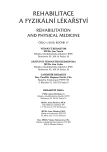-
Medical journals
- Career
Measurement of EMG Activity of Muscular Tissue after the Application of Whole-body Cool Therapy ( - 130 °C)
Authors: H. Krumlová; D. Pánek; D. Pavlů
Authors‘ workplace: Katedra fyzioterapie FVTS UK, Praha vedoucí katedry doc. PaedDr. D. Pavlů, CSc.
Published in: Rehabil. fyz. Lék., 17, 2010, No. 1, pp. 14-20.
Category: Original Papers
Overview
The aim of the study was to follow muscular tissue electric activity after the application of whole-body cool therapy by means of surface EMG. The attention was devoted to the detection of MVC (maximum intentional contraction) before and after entering the cold chamber. Moreover, the authors followed the beginning of muscular fatigue in the course of isometric contraction before and after the application of whole-body cold therapy (CChT). Muscular activity was recorded from brachial m. biceps. Five top sportsmen at the age of 20-35 years participated in the measurement. Results of the study revealed that surface electromyography can detect changes in electric activity after the application of wehole-body cool therapy. In four of the five measured probands there was a delayed beginning of muscular fatigue after the application of CChT. Moreover, the application of CChT resulted in increased MVC in all five measured probands.
Key words:
whole-body cool therapy, cryotherapy, surface electromyography, muscular fatigue, isometric muscular contraction, maxima intentional muscular concentration (MVC)
Sources
1. AMBLER, Z.: Neurologie pro posluchače všeobecného lékařství. Praha, Státní pedagogické nakladatelství, 1990, s. 6-22.
2. ČIHÁK, R.: Anatomie 3. Praha, Grada Publishing, 2004, s. 325-467.
3. DELUCA ,C. J.: The use of surface elektromyography in biomechanics. 1993. http:www.delsys.com/Knowledge Center/Tutorials.html
4. DYLEVSKÝ, I.: Obecná kineziologie. Praha, Grada Publishing, 2007, s. 159-173.
5. GROMNICA, R., ŠMUK, L., BAJGAR, M., DUDYS, R.: Metoda celotělové chladové terapie poprvé v ČR. Rehabil. fyz. Lék., roč. 12, 2005, č. 4, s. 3-4.
6. JANDOVÁ, D.: Neurofyziologie termoregulace. Studijní materiál 3. ročníku fyzioterapie. Praha, 2006.
7. JOCH, W., ÜCKERT, S., FRICKE, R.: Bedeutung kurzfristig und hoch dosierter Kalteapplikation. BISp-Jahrbuch, Institut für Sportwissenschaft. Universität Münster, 2003, s. 245-252.
8. KRAUSE, B. A., HOPKINS, J. T., INGERSOLL, CH. D., CORDOVA, M. L., EDWARDS, J. E.: The relationship of ankle temperature during cooling and rewarmingto the human soleus H reflex. J. Sport. Rehabil., 9, 2000, s. 253-262.
9. LEPPALUOTO, J., WESTERLUND, T., HUTTUNEN, P., OKSA, J., SMOLANDER, J., DUGUE, B.: Effects of long-term whole-body cold exposures on plasma concentrations of ACTH, beta-endorphin, cortisol, catecholamines and cytokines in healthy females. The Scandinavian Journal of Clinical & Laboratory Investigation, 68, 2008, 2, s. 145-153.
10. PÁNEK, D., PAVLŮ, D., ČEMUSOVÁ J.: Rychlost vedení akčního potenciálu svalu jako identifikátor nástupu svalové únavy v povrchové elektromyografii. Rehabil. fyz. Lék., roč. 16, 2009, č. 3, s. 96-101.
11. PÁNEK, D., PAVLŮ, D., ČEMUSOVÁ J.: Počítačové zpracování dat získaných pomocí povrchového EMG. Rehabil. fyz. Lék. s. roč. 16, 2009, č. 4, s. 139–149.
12. PAPENFUSS, W.: Die Kraft aus der Kälte, Ganzkörperkältetherapie bei -110 °C. Regensburg, Edition K, 2005, s. 15-49.
13. PFEIFER, J.: Neurologie v rehabilitaci. Praha, Grada Publishing, 2007, s. 183-186.
14. PODĚBRADSKÝ, J., VAŘEKA, F.: Fyzikální terapie II. Praha, Grada Publishing, 1998, s. 76.
15. TROJAN, S.: Lékařská fyziologie. Praha, Grada Publishing, 2003, s. 423-430.
16. VÉLE, F.: Přehled klinické kineziologie a patokineziologie pro diagnostiku a terapii poruch pohybové soustavy. Praha, Triton, 2006, s. 46-96.
17. WESTERLUND, T., OKSA, J., SMOLANDER, J., MIKKELSSON, M.: Thermal responses during and after whole-body cryotherapy ( -110°C). Journal of Thermal Biology, 28, 2003, s. 601-608.
18. WESTERLUND, T., SMOLANDER, J., KOSKINEN, A. U., MIKKELSSON, M.: The blood pressure responses to an acute and long - term, whole-body cryotherapy (-110°C) in men and women. Journal of Thermal Biology, 29, 2004, s. 285-290.
19. WESTERLUND, T., UUSITALO, A., SMOLANDER, J., MIKKELSSON, M.: Heart rate variability in women exposed to very cold air (-110 °C) during whole-body cryotherapy. Journal of Thermal Biology, 31, 2006, s. 342-346.
20. WESTERLUND, T., OKSA, J., SMOLANDER, J., MIKKELSSON, M.: Thermal responses during and after whole-body cryotherapy (-110 °C). Journal of Thermal Biology, 28, 2003, s. 601-608.
21. ZEMAN, V.: Adaptace na chlad u člověka. Praha, Galén, 2006, s. 43-63.
Labels
Physiotherapist, university degree Rehabilitation Sports medicine
Article was published inRehabilitation & Physical Medicine

2010 Issue 1-
All articles in this issue
- Assessment of Health State and Working Capacity of People Suffering from Nervous System Diseases
- Sarcopenia – Possibilities of Diagnostics and Influencing by Physiotherapy
- Measurement of EMG Activity of Muscular Tissue after the Application of Whole-body Cool Therapy (- 130 °C)
- Water Surface Electromyography – WaS-EMG
- The Use of 3D Kinematic Gait Analysis for Rehabilitation Purposes – the Vicon MX System
- Present Editor Requirements for Professional Texts in Rehabilitation Area
- Rehabilitation & Physical Medicine
- Journal archive
- Current issue
- Online only
- About the journal
Most read in this issue- Sarcopenia – Possibilities of Diagnostics and Influencing by Physiotherapy
- The Use of 3D Kinematic Gait Analysis for Rehabilitation Purposes – the Vicon MX System
- Assessment of Health State and Working Capacity of People Suffering from Nervous System Diseases
- Measurement of EMG Activity of Muscular Tissue after the Application of Whole-body Cool Therapy (- 130 °C)
Login#ADS_BOTTOM_SCRIPTS#Forgotten passwordEnter the email address that you registered with. We will send you instructions on how to set a new password.
- Career

